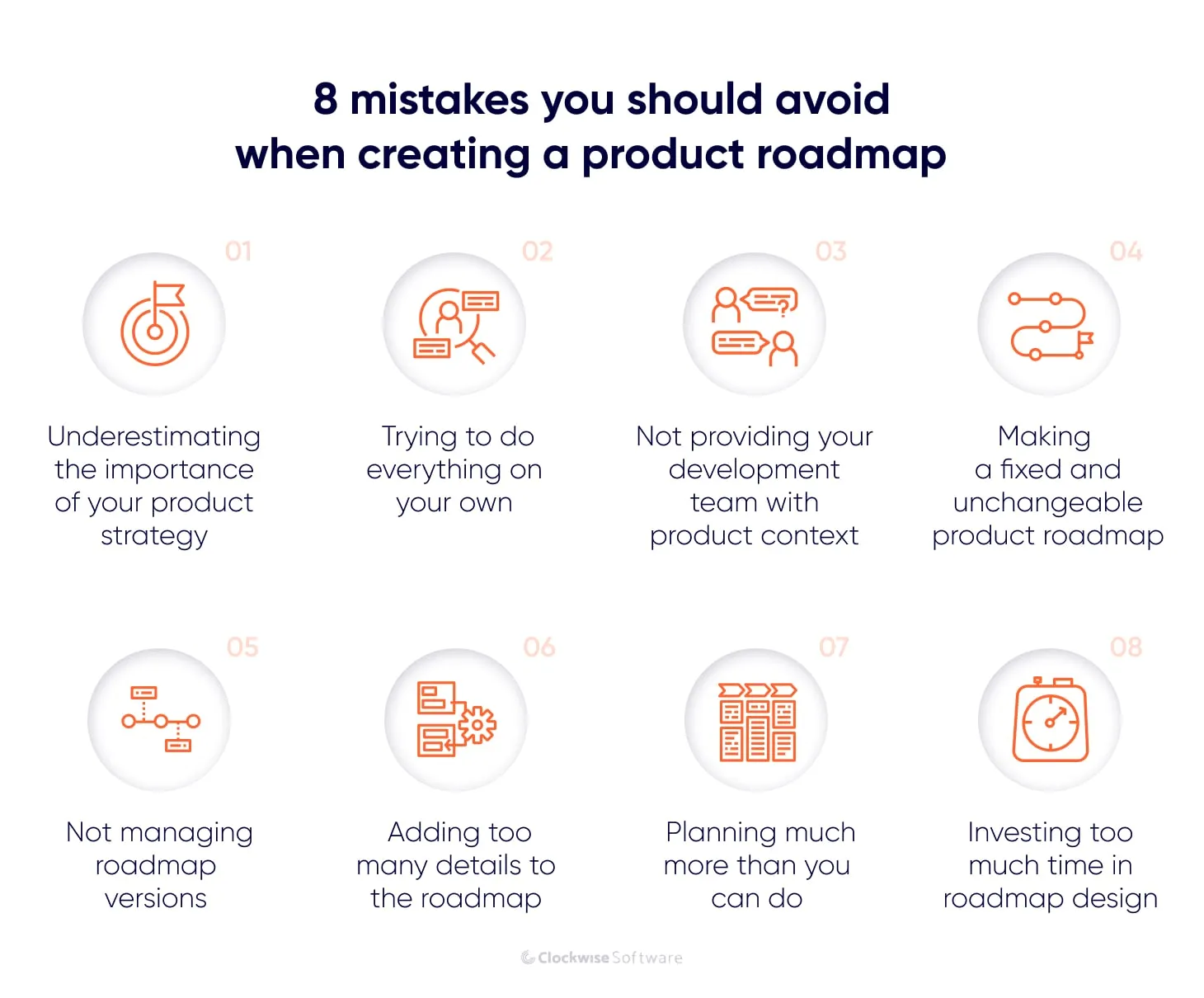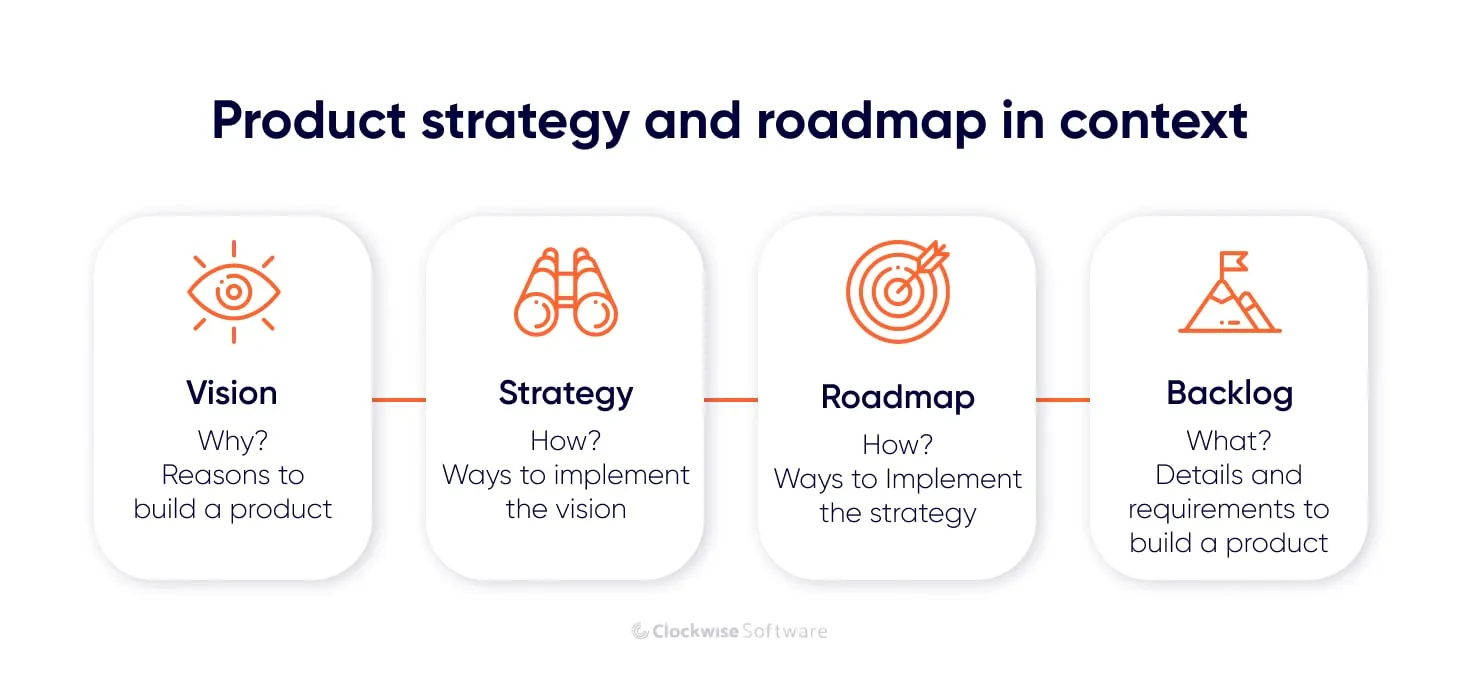What we do
Services
Experts in
A software product roadmap describes your project’s progress over time. This is a document that helps you communicate your idea to all project stakeholders and decide how to implement your vision in the app’s features.
A product roadmap is an irreplaceable component of your product planning. It helps you to express strategic decisions, as Roman Pichler, a product management expert, describes in his book Strategize: Product Strategy and Product Roadmap Practices for the Digital Age.
Even though it seems like putting down your goals and app features on a sheet of paper shouldn’t turn into a headache, for some entrepreneurs and product managers, it does — especially for those navigating complex software product development services or bringing a new digital solution to market.
Mistakes made at the product roadmapping stage may lead to delays, worries, debates, wasted time and money, and, in some cases, even to product failure.
In this post, you can find the eight most dangerous roadmapping mistakes and get tips on how to avoid them.
What mistakes should you avoid to build an accurate and useful product roadmap? Let's see.

Developing a product roadmap is not the first step to take on your way to your product launch. Before you dive into roadmapping, you need to get acquainted with such concepts as product vision and product strategy. A detailed vision and well-thought-out strategy lays the groundwork for an accurate product roadmap.

However, developing your product vision and strategy takes time. Answering related questions may take days and weeks.
If you don’t have much time, you may want to skip this step and dive right into roadmapping and coding.
This is the initial mistake you should avoid.
Don’t create a roadmap if you don’t have a valid product strategy available or if you cannot look beyond the first public release.
— Roman Pichler, Strategize: Product Strategy and Product Roadmap Practices for the Digital Age
Having a product strategy means you have studied the market, developed a unique selling proposition, and shortlisted necessary features. Otherwise, your development plans are too vague and will likely take you nowhere.
Start with developing a product strategy to avoid mistakes with product roadmapping.
You can do everything yourself.
However, in the first case, you will probably invest months and years in your product, burn out, and even fail in the intense competition in which every day and every reaction to users’ needs matter.
In the second case, even if you build the finest documentation, you’ll still need to check in with the development team, listen to recommendations and best practices, take into account the technical side of the project, and then edit and correct every single document you’ve worked on. Doing the job twice may bring the expected results, but is it worth it?
Effective delegation and dependable partnership are the cornerstones of project success. At the initial stages of your product growth, you need a small but skilled team willing to share their experience to make your product better.
With a reliable team, you can cut your time to market.
And with a reliable team, you can also prioritize features in your product roadmap and launch a successful MVP.
This mistake is especially common among entrepreneurs that work with outsourcing development teams.
What do your product discovery and product development teams know about your plans, objectives, and business? Have you provided them with enough details for long-term, fruitful cooperation?
You delegate software design, coding, and testing to an external company. Do you really need to provide your team with a description of your company and product details?
Yes, you do.
Your team needs to know everything they can about your plans, from design preferences to your previous products, risks you’re afraid of, and the overall business context.
It’s not enough to have strong people equipped with modern tools and techniques. The product teams need to have the necessary business context.
— Marty Cagan, INSPIRED: How to Create Tech Products Customers Love
Before you start building a product roadmap, talk to your team and make sure they have everything they need to participate in roadmapping and commit to your product development.
This is the first step in turning your development team into a reliable partner, advisor, and consultant.
You’ve invested a large amount of time in your product vision, strategy, and roadmap. Now, it’s time to act. And you won’t ever go back to these concepts again, will you? You have the critical documentation ready, and it’s the truth you can stick to for months and years.
Unfortunately, it’s not.
You need to constantly correct your vision, strategy, and roadmap as your product grows and matures.
Multiple factors may affect your product, and the market situation is one of the most influential. The market may change swiftly, just like the needs of your target audience. And if you fail to adjust to changes and satisfy rising demand, your product may fail too.
A fixed roadmap communicates false certainty.
— Teresa Torres, Continuous Discovery Habits: Discover Products that Create Customer Value and Business Value
A fixed roadmap reduces your chances to succeed and restrains all stakeholders from improving the product. It belittles the efforts of business analysts and UI/UX designers who aim to improve your product. It also ties developers’ hands and leads to one possible outcome: creating all the features from your roadmap. But it’s very likely that no one is going to need those features by the time they’re built.
A product roadmap is not a guarantee; it is a high-level plan that describes the likely growth of your product based on what you currently know.
— Roman Pichler, Strategize: Product Strategy and Product Roadmap Practices for the Digital Age
How can you avoid this mistake?
Remember that a product roadmap needs to be frequently updated.
Make it clear within your team that a roadmap is not carved in stone.
Choose a convenient roadmap format so it will be easier for you to update it.
Use our guide on product roadmapping to decide how often you need to update your roadmap and what factors impact the update frequency.
Together with your product team, you’ve built an initial version of the product roadmap. As it’s traveled from stakeholder to stakeholder and from meeting to meeting, you’ve added a couple more details. Then you’ve deleted a bunch of goals. Then you’ve reprioritized some features.
As a result, you may have several documents on your Google Drive:
Some stakeholders have an initial version of the document; others are now getting through v.1.0, and you are still reviewing the changes in the document with reprioritized features.
A product roadmap must keep all stakeholders on the same page.
Making several versions of a roadmap and not making sure all specialists involved use the same document may be a serious mistake. Mismatched expectations and failed releases are only two of the possible consequences.
To avoid this mistake, try one of these methods:
Jira or a similar tool may help you avoid this issue and keep all stakeholders in sync.
Depending on what you map on the product timeline, you can develop a feature-based or goal-oriented roadmap.
Whether you create a feature-based or a goal-oriented roadmap, try not to add too many details. Don’t put epics or user stories on a roadmap. Your product roadmap is extremely prone to changes; there’s no need to describe epics because there’s no guarantee you’re ever going to work on them.
Imagine your product as a high-resolution picture on social media. This picture is your product vision. As you zoom in, you can see a product strategy. Keep zooming and you get a product roadmap on your screen. One more zoom and a product backlog appears.
Epics, user stories, product requirements, technology requirements, and other details should be added to the product backlog.
Your potential competitors keep on adding new features to their products, and you don’t want to fall behind. You strive to do everything possible to stay among the market leaders. Thus, your product roadmap includes dozens and dozens of rows; you change deadlines and set unrealistic timetables. Your goal is to do everything you can.
Even though you can’t.
Pressure from competitors, investors, and customers may push you to make wrong decisions. One of those is adding too many points to your roadmap even though you clearly see that tasks can’t be done.
You and your team can accomplish a limited number of missions. You can get done a limited number of tasks, and if you set unrealistic expectations, you risk facing multiple more problems that would be much harder to solve than a roadmapping challenge.
Unrealistic feature lists and deadlines may ruin your relationship with a development partner.
If you present an unrealistic roadmap to your investors and then fail to meet promises, you risk disappointing them or even losing funds.
Talk to your team and add as many features or goals to your release as you can definitely get done. It will be brilliant if you can do more. But you won’t damage your relations and your reputation if you are realistic when working on your product roadmap.
A product roadmap is one of the essential documents you need to start working on your app. No wonder you want it to look good.
At the same time, it doesn’t need to look good. Opt for one of the standard product roadmap formats:
You can find out more about each of these formats in our article about product roadmap development.
Don’t waste time on roadmap design. This document doesn’t have to look fancy or sophisticated. It just needs to contain crucial information about steps you need to take to transform your idea into an app. When initiating the development of your next product, it’s more effective to invest your time and effort in the content of the product roadmap, not in adding bells and whistles to it.
Simple tips may save you from making mistakes and save your product roadmap from errors and failure.
What should you do if you still have concerns and worries about roadmapping mistakes?
In Inspired, Marty Cagan says that in some cases, a detailed product vision and clear business objectives may replace a product roadmap. However, it depends completely on your particular product, business, and needs.
By delegating product roadmapping to professionals, you immediately avoid mistake #2 (trying to do everything on your own) and save time for other critical business tasks and decisions.
Product roadmap development is a component of the project discovery phase. During this phase, a team of skilled business analysts, project managers, UI/UX designers, and IT engineers identify possible project risks, conduct a technical feasibility study, and create product documentation.
With a reliable team, you can avoid roadmapping mistakes and create an accurate and useful product roadmap.
